Live
- Sobhita, Naga Chaitanya to have ‘over eight hour long wedding rituals’
- Naqvi calls for unity amid communal tension in Sambhal; slams Oppn
- India must move ahead on path of unity, Constitution: Rahul Gandhi on Sambhal violence
- Rashmika Mandanna Drops Major Hint About Her Wedding Plans with Vijay Deverakonda
- Double murder accused arrested
- Austria's Freedom Party wins 1st state election in Styria
- GMC related services through call centre from today
- JPC on Waqf Bill seeks extension for comprehensive consultations
- PM to take part in a host of programmes in Vizag on Nov 29
- Bigg Boss Telugu 8 - 13th Week Nominations: Intense Fights and Key Contestants Nominated









